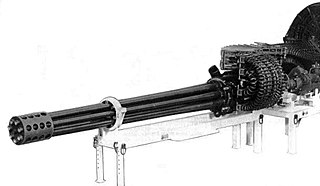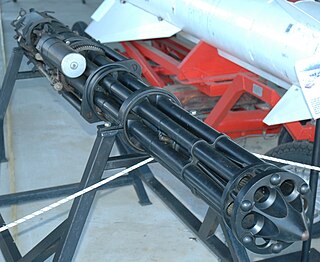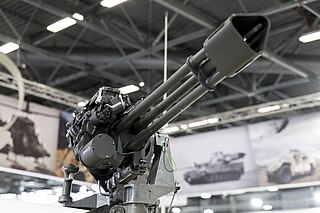History
In January 1915, Karl Gast invented the gun, which would become known as the Gast Maschinengewehr Modell 1917, while working for the Vorwerk company, the first weapon was produced in January 1916. Gast took out patents on 21 January 1916 and 13 February 1917, describing his weapon as "a double-barreled machine gun with recoiling barrels". [2] Rates of fire of 1,600 rounds per minute were achieved during trials.
In August 1917, Gast's demonstration so impressed ordnance experts that a production order for 3,000 guns, along with spare parts and ten ammunition drums for each gun, was awarded to Vorwerk und Companie [1] at a unit price of 6,800 marks each. Delivery of the first 100 guns was promised for 1 June 1918, with production increasing to 500 guns per month by September 1918. Production of the weapon exceeded these initial projections, and the weapons were favorably received with promises of an order for a further 6,000 guns being made in September 1918.
A version of the gun in 13 mm (13.2×92mmSR), the Gast-Flieger MG, was also under development, which used the same ammunition as the Maxim MG TuF and had two, curved, box magazines. [3]
The gun was rarely used in service, and its existence was kept secret until three years after the Armistice; in 1921 the Allied Control Commission finally became aware of the Gast gun when a cache of 25 of the guns, ammunition, and designs was found near Königsberg. [1] Gast himself had applied for a US patent in 1920, which was issued in 1923. A Gast gun was evaluated by the US Army and found to be reliable and mechanically practical. However it was not felt to offer a sufficient advantage over existing machine guns to justify the expense of producing the weapon.
Years later the Gast design was copied by Soviet engineers seeking to improve firing rates of their aircraft autocannon without resorting to the Gatling gun concept or powered revolver cannon. Previous efforts either had relatively poor rates of fire, or used gas operated revolvers, neither of which proved entirely satisfactory. The Gast concept was adopted for the Gryazev-Shipunov GSh-23, which quickly replaced many previous designs. It was also used in the larger 30 mm version, the Gryazev-Shipunov GSh-30-2, as well as the 2A38 autocannon found on the 2K22 Tunguska.

The M61 Vulcan is a hydraulically, electrically, or pneumatically driven, six-barrel, air-cooled, electrically fired Gatling-style rotary cannon which fires 20 mm × 102 mm rounds at an extremely high rate. The M61 and its derivatives have been the principal cannon armament of United States military fixed-wing aircraft for over sixty years.

An autocannon, automatic cannon or machine cannon is a fully automatic gun that is capable of rapid-firing large-caliber armour-piercing, explosive or incendiary shells, as opposed to the smaller-caliber kinetic projectiles (bullets) fired by a machine gun. Autocannons have a longer effective range and greater terminal performance than machine guns, due to the use of larger/heavier munitions, but are usually smaller than tank guns, howitzers, field guns or other artillery. When used on its own, the word "autocannon" typically indicates a non-rotary weapon with a single barrel. When multiple rotating barrels are involved, such a weapon is referred to as a "rotary autocannon" or occasionally "rotary cannon", for short.

The General Electric GAU-8/A Avenger is a 30 mm hydraulically driven seven-barrel Gatling-style autocannon that is primarily mounted in the United States Air Force's Fairchild Republic A-10 Thunderbolt II. Designed to destroy a wide variety of ground targets, the Avenger delivers very powerful rounds at a high rate of fire. The GAU-8/A is also used in the Goalkeeper CIWS ship weapon system, which provides defense against short-range threats such as highly maneuverable missiles, aircraft, and fast maneuvering surface vessels. The GAU-8/A is currently produced by General Dynamics.
The General Dynamics GAU-12/U Equalizer is a five-barrel 25 mm Gatling-type rotary cannon. The GAU-12/U is used by the United States, Italy and Spain, which mount the weapon in their attack jets such as the AV-8B Harrier II, airborne gunships such as the Lockheed AC-130, and land-based fighting vehicles. A lighter four-barrel version, designated GAU-22/A, is mounted on F-35 Lightning II fighter jets.

A revolver cannon is a type of autocannon, commonly used as an aircraft gun. It uses a cylinder with multiple chambers, like those of a revolver handgun, to speed up the loading-firing-ejection cycle. Some examples are also power-driven, to further speed the loading process. Unlike a rotary cannon, a revolver cannon only has a single barrel, so its spun weight is lower. Automatic revolver cannons have been produced by many different manufacturers.

The Gryazev-Shipunov GSh-6-23 is a six-barreled 23 mm rotary cannon used by some modern Soviet/Russian military aircraft.

The Nudelman-Richter NR-23 is a Soviet autocannon widely used in military aircraft of the Soviet Union and Warsaw Pact. It was designed by A. E. Nudelman and A. A. Richter to replace the wartime Nudelman-Suranov NS-23 and Volkov-Yartsev VYa-23, entering service in 1949.
The Gryazev-Shipunov GSh-23 is a twin-barreled 23 mm autocannon developed in the Soviet Union, primarily for military aircraft use. It entered service in 1965, replacing the earlier Nudelman-Rikhter NR-23 and Rikhter R-23.

The Gryazev-Shipunov GSh-30-2 (ГШ-30-2) or GSh-2-30 is a Soviet dual-barrel autocannon developed for use on certain ground attack military aircraft and helicopters.

The Gryazev-Shipunov GSh-6-30 is a Russian 30 mm rotary cannon aircraft-mounted and naval autocannon used by Soviet and later CIS military aircraft. The GSh-6-30 fires a 30×165mm, 390 g projectile.

A gun pod is a detachable pod or pack containing machine guns, autocannons, revolver cannons, or rotary cannons and ancillaries, mounted externally on a vehicle such as a military aircraft which may or may not also have its own guns.

A rotary cannon, rotary autocannon, rotary gun or Gatling cannon, is any large-caliber multiple-barreled automatic firearm that uses a Gatling-type rotating barrel assembly to deliver a sustained saturational direct fire at much greater rates of fire than single-barreled autocannons of the same caliber. The loading, firing and ejection functions are performed simultaneously in different barrels as the whole assembly rotates, and the rotation also permits the barrels some time to cool. The rotating barrels on nearly all modern Gatling-type guns are powered by an external force such as an electric motor, although internally powered gas-operated versions have also been developed.

A heavy machine gun (HMG) is significantly larger than light, medium or general-purpose machine guns. HMGs are typically too heavy to be man-portable and require mounting onto a weapons platform to be operably stable or tactically mobile, have more formidable firepower, and generally require a team of personnel for operation and maintenance.

The GAU-19/A is an electrically driven, three-barrel rotary heavy machine gun that fires the .50 BMG (12.7×99mm) cartridge.

The Shipunov 2A42 is a Soviet/Russian 30 mm autocannon. It is built by the Tulamashzavod Joint Stock Company and named after A. G. Shipunov.

The 23×115mm round is used in Soviet (USSR)/Russian/CIS aircraft autocannon. Although superseded by the 30×165mm round the Russian Air Force still uses it in the GSh-23L and the GSh-6-23. This round still serves in many countries and is widely available. The projectile weight is 175 grams.
The Rikhter R-23 is an aircraft autocannon developed for the Soviet Air Force starting in the late 1950s. It was designed to be as short as possible to avoid problems found on high-speed aircraft when the guns were pointed into the airstream. The R-23 was a gas operated revolver cannon that used gas bled from holes in the barrel to provide the motive force. Firing up to 2,600 rpm, the R-23 was the fastest firing single-barrel cannon ever introduced into service.

The Gryazev-Shipunov GSh-30-1 is a 30 mm autocannon designed for use on Soviet and later Russian military aircraft, entering service in the early 1980s. Its current manufacturer is the Russian company JSC Izhmash. The name GSH-30-1 is formed from the surnames of the designers Gryazev (Грязев) and Shipunov (Шипунов), the caliber of 30 mm and the single-barrel design of the gun itself.
Gryazev-Shipunov may refer to:

A repeating firearm or repeater is any firearm that is capable of being fired repeatedly before having to manually reload new ammunition into the weapon.
















